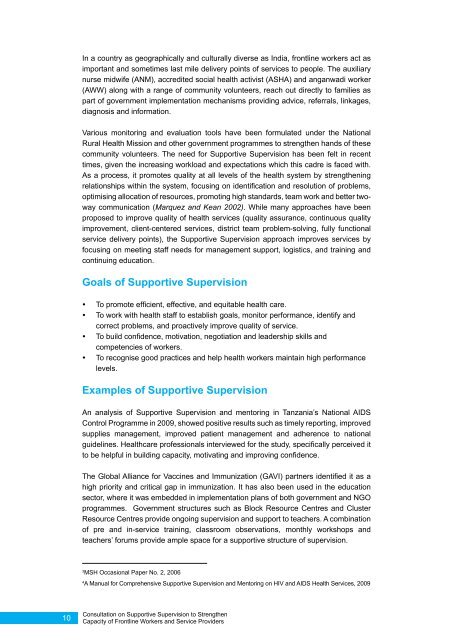Download the complete report - Unicef
Download the complete report - Unicef
Download the complete report - Unicef
Create successful ePaper yourself
Turn your PDF publications into a flip-book with our unique Google optimized e-Paper software.
In a country as geographically and culturally diverse as India, frontline workers act as<br />
important and sometimes last mile delivery points of services to people. The auxiliary<br />
nurse midwife (ANM), accredited social health activist (ASHA) and anganwadi worker<br />
(AWW) along with a range of community volunteers, reach out directly to families as<br />
part of government implementation mechanisms providing advice, referrals, linkages,<br />
diagnosis and information.<br />
Various monitoring and evaluation tools have been formulated under <strong>the</strong> National<br />
Rural Health Mission and o<strong>the</strong>r government programmes to streng<strong>the</strong>n hands of <strong>the</strong>se<br />
community volunteers. The need for Supportive Supervision has been felt in recent<br />
times, given <strong>the</strong> increasing workload and expectations which this cadre is faced with.<br />
As a process, it promotes quality at all levels of <strong>the</strong> health system by streng<strong>the</strong>ning<br />
relationships within <strong>the</strong> system, focusing on identification and resolution of problems,<br />
optimising allocation of resources, promoting high standards, team work and better twoway<br />
communication (Marquez and Kean 2002). While many approaches have been<br />
proposed to improve quality of health services (quality assurance, continuous quality<br />
improvement, client-centered services, district team problem-solving, fully functional<br />
service delivery points), <strong>the</strong> Supportive Supervision approach improves services by<br />
focusing on meeting staff needs for management support, logistics, and training and<br />
continuing education.<br />
Goals of Supportive Supervision<br />
• y To promote efficient, effective, and equitable health care.<br />
• y To work with health staff to establish goals, monitor performance, identify and<br />
correct problems, and proactively improve quality of service.<br />
• y To build confidence, motivation, negotiation and leadership skills and<br />
competencies of workers.<br />
• y To recognise good practices and help health workers maintain high performance<br />
levels.<br />
Examples of Supportive Supervision<br />
An analysis of Supportive Supervision and mentoring in Tanzania’s National AIDS<br />
Control Programme in 2009, showed positive results such as timely <strong>report</strong>ing, improved<br />
supplies management, improved patient management and adherence to national<br />
guidelines. Healthcare professionals interviewed for <strong>the</strong> study, specifically perceived it<br />
to be helpful in building capacity, motivating and improving confidence.<br />
The Global Alliance for Vaccines and Immunization (GAVI) partners identified it as a<br />
high priority and critical gap in immunization. It has also been used in <strong>the</strong> education<br />
sector, where it was embedded in implementation plans of both government and NGO<br />
programmes. Government structures such as Block Resource Centres and Cluster<br />
Resource Centres provide ongoing supervision and support to teachers. A combination<br />
of pre and in-service training, classroom observations, monthly workshops and<br />
teachers’ forums provide ample space for a supportive structure of supervision.<br />
3<br />
MSH Occasional Paper No. 2, 2006<br />
4<br />
A Manual for Comprehensive Supportive Supervision and Mentoring on HIV and AIDS Health Services, 2009<br />
10<br />
Consultation on Supportive Supervision to Streng<strong>the</strong>n<br />
Capacity of Frontline Workers and Service Providers

















